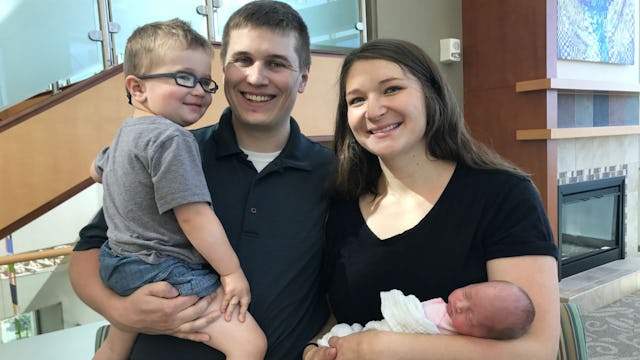Mom Says 'Count The Kicks' App Saved Her Baby's Life

Iowa mom believes “Count the Kicks” app is a lifesaver
Pregnant women are often told to count their baby’s kicks when they get closer to their due date. But let’s be honest, sometimes work is distracting and you forget. Or you maybe you have “pregnancy brain” and can’t remember a damn thing or maybe you have other children who keep you really busy. It can be pretty hard to keep track.
Enter modern technology. A relatively new app that’s gaining lots of attention lately called, “Count the Kicks,” can help you keep track of your baby’s kicks and record their patterns every day. It’s a game-changer for pregnant women, and one Iowa mom also believes the app is a lifesaver.
Emily Eekhoff, an Iowa mom of two, just had a really scary experience. One that no parent would ever want to ever deal with.
“I haven’t let my mind go there,” Eekhoff tells WHOTV. “They could have been burying our baby instead.”
Image via Count the Kicks/Emily Price
Eekhoff was 33 weeks pregnant when she noticed that her baby girl’s activity wasn’t the same as it usually is. “We were a little scared that things weren’t right,” she says.
She had been using the Count the Kicks app to help monitor her baby’s movements every day. Through the app’s history feature, Eekhoff was able to see that her baby’s movement had slowed down. It’s widely believed that decreased fetal activity often means the baby is in distress or their condition is deteriorating. Eekhoff recognized this as a possible warning sign, so she and her husband went to the hospital. “We are really thankful that we did,” Eekhoff says.
Image via Count the Kicks/Emily Price
It’s there that they discovered something truly alarming. Doctors found that the umbilical cord had become wrapped around the baby’s neck three times. One loop around a baby’s neck is usually not a big deal, but three times (and tight) is considered potentially fatal. The medical staff at the hospital performed an emergency C-section and delivered Eekhoff’s daughter, Ruby. She had to spend 20 days in the NICU to get stronger and healthier, but is home now.
“I think God was looking out for us that day, and we had tools to know when to come in and get help when we needed it,” Eekhoff tells USA Today.
Image via Count the Kicks/Emily Price
The Count the Kicks program was created by five Iowa women who had stillbirths. Their program encourages women in the third trimester of pregnancy to track how long it takes them to feel 10 kicks.
“When you and I don’t feel well we move less. We want to lie on the couch or in bed and not move. It’s the same thing with babies. When they are not feeling well, they move less,” Emily Price, the executive director of the organization said in a press conference. “Sometimes kick counting is the only indication — and the earliest indication — that something is wrong in there.”
I downloaded the app and can say the interface is super easy to use. In addition to counting the kicks, it provides you with a history of your baby’s movements (so you can make sure your baby is following the same patterns daily) and it has a feature that lets you set a text or calendar reminder for when it’s time to count kicks. GENIUS. And it’s free to use.
Image via Count the Kicks/Emily Price
So, can counting kicks reduce stillborn rates? There’s some evidence that it’s possible. Stillborn is defined as the loss of a baby before or during delivery after 20 weeks of pregnancy. According to the Centers for Disease Control and Prevention (CDC) about 24,000 babies are stillborn in the U.S. each year, which is about one percent of all pregnancies.
The Count the Kicks program is super popular in Iowa (where it all started) and is gaining momentum in the country and around the world. Price estimates that they have about 3,000 new downloads a month. The most striking evidence for the fact that counting kicks can reduce stillbirth rates is this statistic: in Iowa, there has been a 26 percent decline in stillbirth rates in the last five years, according to Price. The rest of the country has remained steady.
“If we can reduce the entire country’s stillbirth rate by 26 percent, as we’ve done here in Iowa, we will save more than 6,000 babies every single year,” she said. “That’s 6,000 families who will have been saved from the heartache of losing their child.”
Part of this pioneering program is the app, which can help save lives, just like it did for baby Ruby.
This article was originally published on